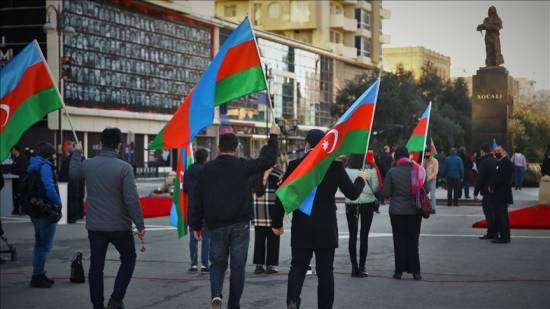The Azerbaijani capital Baku on Friday commemorated the anniversary of the Khojaly massacre, in which hundreds of Azerbaijani citizens were killed by Armenian forces 29 years ago.
On Feb. 26, 1992, as many as 613 innocent Azerbaijani citizens, including 106 women, 63 children, and 70 elderly people, were indiscriminately killed, with hundreds more wounded by Armenian troops in their attack on the town of Khojaly in Azerbaijan's Upper Karabakh region.
On Friday an official commemoration ceremony was held at the Cry of the Mother Monument with the participation of Azerbaijani President Ilham Aliyev, and then the monument was opened to the public.
People came to the monument with Azerbaijani flags and posters and left carnations.
Survivors of the massacre and the relatives of those who lost their lives also visited the monument.
Some of the relatives of the martyrs read out prayers, and some could not hold back their tears, recalling the painful events of 29 years ago.
Chingiz Bayramov told Anadolu Agency that they commemorate the victims of Khojaly every year.
"Our heroic army saved our land. Now this year, as a victorious people, we commemorate our martyrs," he said, referring to the liberation last fall of Karabakh from Armenian occupation.
"We will never forget this bloody disaster. The Khojaly victims were avenged. But we are working to make this disaster known to the world," he added.
Nagorno-Karabakh
On Feb. 26, 1992, with the Soviet Union just dissolved, Armenian forces took over the town of Khojaly in occupied Karabakh after battering it using heavy artillery and tanks, assisted by infantry.
The massacre is seen as one of the bloodiest atrocities by Armenian forces against Azerbaijani civilians in the Upper Karabakh region, which was liberated by Azerbaijan forces last fall after decades of occupation.
The two-hour Armenian offensive on Khojaly killed 613 Azerbaijani citizens – including 106 women, 63 children and 70 elderly people – and seriously injured 487 others, according to Azerbaijani figures.
Some 150 of the 1,275 Azerbaijanis that the Armenians captured during the massacre remain missing. In the massacre, eight families were completely wiped out, while 130 children lost one parent and 25 children lost both parents.
Relations between the former Soviet republics of Azerbaijan and Armenia have been tense since 1991, when the Armenian military occupied Nagorno-Karabakh, also known as Upper Karabakh, a territory recognized as part of Azerbaijan, and seven adjacent regions.
New clashes erupted on Sept. 27, 2020, and ended with a Russian-brokered truce six weeks later.
Baku liberated several strategic cities and nearly 300 of its settlements and villages from Armenian occupation during this time.
Before this, about 20% of Azerbaijan's territory had been under illegal Armenian occupation for nearly three decades./aa


